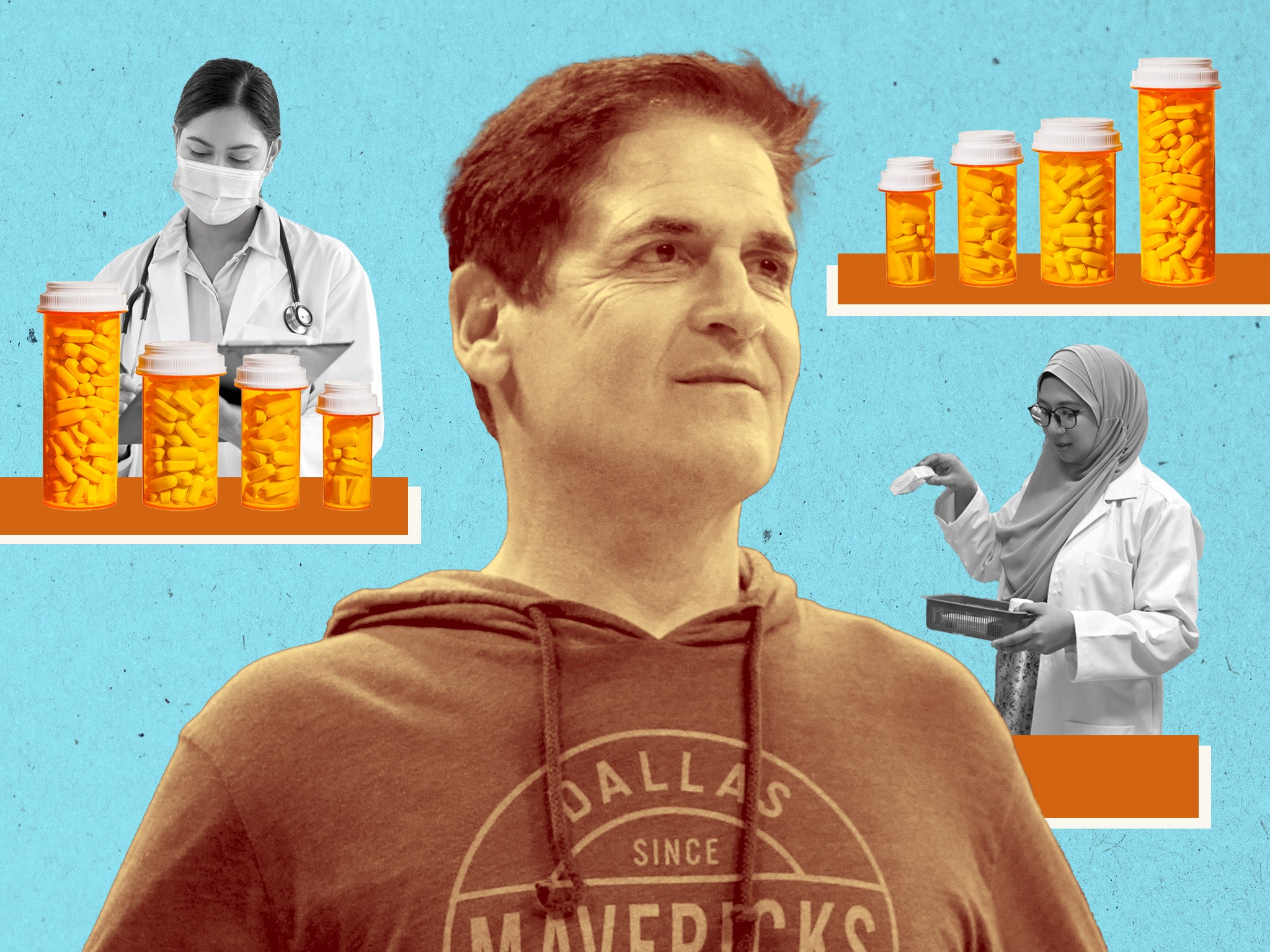Can billionaire celebrity Mark Cuban fix America’s broken health system?
The celebrity investor has teamed up with a soft-spoken radiologist to tackle the USA’s healthcare crisis – and he has drug industry middlemen squarely in his sights, reports Io Dodds


In August 2015, a 32-year-old former hedge fund manager named Martin Shkreli bought the rights to a decades-old drug used to treat malaria and Aids complications and raised its price from $13.50 (£10.35) per pill to $750 per pill.
That 5,000 per cent hike briefly made Shkreli – who was later jailed for seven years for an unrelated fraud scheme – one of the most hated people in America, trashed by both Hillary Clinton and Donald Trump and branded the "Pharma Bro" in news stories read by outraged people across the world.
One of those people was Dr Alex Oshmyansky, now 37, a softly-spoken diagnostic radiologist who had been working on a study where some patients died because they could could not access a hypertension drug that cost thousands of dollars for a month's supply, despite its patent having expired decades earlier.
"I had been upset about the cost of high-price drugs for quite some time, but the straw that broke the camel's back was Martin Shkreli," Dr Oshmyansky tells The Independent. "I reached out to some friends on Facebook and was like, 'let's start a non-profit pharmaceutical company that'll just make drugs and sell them at cost!' – with all the naiveté in the world."
Today Dr Oshmyansky's charity has become a for-profit company owned by billionaire tech investor and Shark Tank host Mark Cuban (estimated net worth: $4.7bn), “who has declared it his mission to smash open the US drug industry and cut the price of crucial medications.
"The goal is to be the low-cost provider for all drugs, period, end of story," Mr Cuban told CNN earlier this month. "The one industry where people say every minute of every day, 'we need lower prices' – this is it. We'll just have that very singular mission. You're not going to see us add bells and whistles."
Asked about his biggest life goal over the next few years, he said: "Just f*** up the pharmaceutical industry so bad that they bleed."

Among the biggest savings touted by the Mark Cuban Cost Plus Drug Company – Cost Plus for short – are the anti-parasite drug albendazole, cut from $438 to $33 per dose; the leukemia "miracle drug" imatinib (the generic form of Gleevec), slashed from $9,657 for a month's supply of 400mg pills to $47.10; and the muscle relaxer cyclobenzaprine, down from $1,094 for a month's 30mg capsules to $53.10.
It is one of several upstart companies, including Amazon's new pharmacy business, hoping to slice through the byzantine tangle of middlemen and agents that have wriggled in between medication makers and patients and made American drug spending by far the highest in the world.
But how is it possible to cut prices by so much? And can they survive against the big players for long enough to make lasting change?
The most expensive drug market on Earth
Alec Smith died alone on his bedroom floor in Minnesota at age 26 from complications of type 1 diabetes. He had been born without the ability to naturally produce the hormone insulin, which is necessary for the human body – yet a month's supply of external insulin cost $1,300, a price he could not afford.
Since Mr Smith's death in 2017, his name has become a rallying cry for diabetes activists who accuse Big Pharma of profiting from sky-high insulin prices. Yet that's far from the only life-saving drug that many Americans can't afford.
According to an analysis by Vox, the US accounts for between 64 and 78 per cent of the drug industry's worldwide profits. Americans pay around 3.5 times more money on average for each dose of medication, including both patented drugs and "generic" ones where patents have expired, though some of that cost is borne by health insurers.
The upside is that much more money goes into researching new cures in the USA, and that patients get access to new drugs earlier. That is cold comfort to those who cannot get medication because their insurance company refuses to cover it or they don't have insurance at all.
"There are no price controls in the US [prescription] drug market," Bonnie Kirschenbaum, a pharmacy industry consultant and former drug research executive. "Manufacturer-set prices are drastically higher for brand name drugs with patent protection in the US than elsewhere...
"Once patent expiration is reached and generic entrants are approved, the price of them may drop by as much as 90 per cent compared to the brand. Yet many patients are still trapped into using the brand for various reasons, and their copays" – that is, the cost borne by patients under most insurance plans – "may be extreme."
In the past decade, several companies have announced plans to challenge this. Amazon Pharmacy attempts to exploit the online shopping giant's gigantic delivery infrastructure, having acquired the online pharmacy PillPack for $753m in 2018. Shares in brick and mortar drugstore chains tumbled after the news.
The company has remote pharmacists on-call 24/7 and has been able to cut prices considerably. A month's supply of 400mg imatinib pills goes for $147.20 out of pocket, while a dose of albendazole is $92.72. Unlike Cost Plus, it also sells insulin, with substantial savings off the list price of brand-name drugs available as of Thursday alongside many generics.
GoodRX, which was founded in 2011, is a price comparison service that amalgamates coupons and discounts for various generic and brand name drugs for consumers to pick from. While drug companies, insurers, pharmacies, and doctors offer many such coupons, they can be hard to find or hear about in the first place.
A specialty pharmacy start-up called House Rx recently raised $25m from investors with a plan to challenge dominant drug market middlemen, while another firm, Civica, is trying to do something similar for hospital drugs.
"The disruptor newcomers try to find the most simplistic, cost-effective business model that directly impacts the price the patient pays for drugs," says Ms Kirschenbaum. "They are transparent as opposed to a complicated web.... [they] have designed new systems of acquiring or manufacturing and dispensing [prescription] products that are not hampered and limited by sole source brand patents designations."
How Big Pharma middlemen 'inflate drug prices'
When Dr Oshmyansky began his quest, he thought the answer must lie in manufacturing drugs for less. He was a high achiever, having graduated with a dual doctorate in medicine and mathematics (in another universe, he might have been a high-powered physicist) and later gone to law school for a year just because he was curious.
The problem, however, turned out to lie elsewhere – in an inhabitant of the great US healthcare swamp known as a pharmacy benefit manager, or PBM. These are firms hired by insurance companies to negotiate with drug makers and pharmacies, drawing up a list of drugs called a "formulary" that sets out which drugs insurers will cover.
In theory, this should lead to lower costs – and, in theory, it does. The prices that insurers end up paying for drugs are far smaller than the "list price" that most people hear about due to huge rebates, sometimes as high as 80 per cent, negotiated by PBMs and paid back by drug manufacturers to drug buyers.
PBMs then take some of their fees from a percentage of that rebate, meaning they have an incentive to negotiate massive rebates. But according to a 2021 US Senate report on insulin prices, they have done so by pushing list prices ever higher, allowing them to claim bigger rebates and thus a bigger cut.
"Higher list price increases the dollar value of rebates, discounts, and other fees that a manufacturer can offer to a PBM and health plans, which are based on a percentage of the list price," the Senate committee wrote. "[Our] investigation found instances in which insulin manufacturers were dissuaded from setting lower list prices for their products, which would have likely lowered out-of-pocket costs for patients, due to concerns that PBMs and health plans would react negatively....
"PBMs appeared to be complicit in this behavior. There appeared to be little, if any, attempt to discourage manufacturers from increasing the list price of their products. Instead, the Committee found that PBMs used their size and aggressive negotiating tactics, such as the threat of excluding drugs from formularies, to extract more generous rebates, discounts, and fees from insulin manufacturers."
The PBM industry is also highly concentrated, with just three – CVS Caremark, Cigna, and UnitedHealth – controlling 80 per cent of the market, according to the Drug Channels Institute. That gives them huge bargaining power over drug makers, who need to get their products on insurers' formularies.
"They really do have a stranglehold on our members' business practices," says Ronna Hauser, senior vice president of policy at the National Community Pharmacists' Association (NCPA), which represents small independent pharmacies and regional pharmacy chains.
"They control which patients can visit our members' pharmacies; they control which prescriptions those patients can take; they control how much those patients pay; they control how much our members are paid to dispense those prescriptions...
"Oftentimes they'll choose a higher cost drug for a patient because they've negotiated a bigger rebate from a drug manufacturer, so it's painful for our members when they're forced to dispense a higher cost drug when they know there's an expensive generic drug available."
In such cases, patients often don't see the rebates negotiated for their insurer because their copays are based on the list price, not the actual price. One 2013 study found that 23 per cent of prescriptions filled at pharmacies came with a copay that was higher than what their insurer paid for the drug.
A cold email to Mark Cuban
All this has not gone unnoticed by US politicians and regulators. In testimony earlier this year to the Federal Trade Commission (FTC), one of the USA's two national competition regulators, PBMs were blasted from all corners of the medical industry.
"Break them up!" said Scott Knoer, chief executive of the American' Pharmacists Association. "Lives are literally at stake," said Ted Okon, executive director of the Community Oncology Alliance, which recently published a report describing PBMs as "an oligopoly of rich conglomerates that routinely prey on healthcare practices, providers, and their patients".
Dr Michael Wohlfeiler, chief medical officer of the Aids Healthcare Foundation, called PBMs "a threat to effective models of care and the health of vulnerable populations,", while the American Pharmacy Cooperative said they "take a sledgehammer to patients, to patient access to care, and competition" and accused them of "inflating drug prices and clawing that money back to line their pockets".
Nevertheless, an FTC investigation into PBMs was stymied in February when the agency's governing panel split 2-2 along party lines. President Joe Biden's nomination for a fifth member who could swing such votes is still held up in the Senate.
This is where Cost Plus hopes it can come in. "The PBMs have multiple levels of games that they play to try to extract as much money from the pharmaceutical supply chain," says Dr Oshmyansky. "Over the past thirty years or so, the number of games and the levels of graft have gotten crazy – so we're able to offer really pretty substantial changes just by disintermediating those entities from the supply chain."
Cost Plus prices all its drugs according to a simple formula, which is listed on its website for every medication it sells. It charges the cost of buying the drug from manufacturers, plus a 15 per cent markup to make a profit, $3 for pharmacy labour, shipping, and taxes. For now, it doesn't work with insurers, so you can only buy drugs out of pocket with cash. Still, insured patients with high deductibles or copays may save money.
This method wouldn't work at all outside the USA, where PBMs don't occupy the same position. Here, though, Dr Oshmyansky claims pharmaceutical companies can actually make more money selling through Cost Plus because of all the fees they would otherwise have to pay PBMs.
Even so, when Dr Oshmyansky founded Cost Plus as a non-profit in 2015, his initial fundraising attempts "failed spectacularly". He says: "I went out hat in hand trying to raise financing to get it off the ground for about three and a half years... I did not raise a single dime beyond what I put in myself."

Then, in 2018, he applied to the prestigious Silicon Valley start-up accelerator YCombinator, which suggested he reincorporate the non-profit as a public benefit corporation (PBC). Whereas normal companies have a duty to maximise their shareholders' profits above all else, PBCs are beholden to specific extra goals registered with the government. For Cost Plus, that is "creating positive effects on low income persons and communities by ensuring access to affordable health related products".
It was a cold email that led to Mark Cuban's door. Dr Oshmyansky had heard that the Dallas Mavericks owner regularly reads emails from strangers, and pitched him "kind of on a whim". Mr Cuban loved the idea and became the majority owner, branding the company with his name.
"He's very involved in the day to day operations," says Dr Oshmyansky. "People usually think I'm exaggerating when I say that, but it's true. We had a pharma company visit us just a few weeks ago, and he gave them a tour of the Dallas Mavericks practice facility to help close the deal."
‘We have to build an entire parallel supply chain’
PBMs dispute Dr Oshmyansky's narrative. "PBMs have a proven track record of reducing prescription drug cost for clients and patients," says Greg Lopes, assistant vice president of strategic communications at the Pharmaceutical Care Management Association (PCMA), a trade group. "PBMs exist to increase access to affordable prescription drugs, therefore any accusation that PBMs increase drug costs is patently false and not in any way supported by the facts.”
He says PBM rebates translate into big savings for insurers, citing a study by the US Government Accountability Office (GAO) that found PBMs reduced prescription drug spending by the taxpayer-funded Medicare programme by 20 per cent.
He adds that PBMs' clients often choose them through a bidding or proposal process, allowing the best offer to win out, arguing that although nothing stops insurers and other clients from refusing to work with PBMs, they do so because it reduces costs for them.
Cigna did not respond to a request for an interview, while CVS and UnitedHealth referred inquiries from The Independent to the PCMA.
Dr Oshmyansky anticipates stiff resistance. If Cost Plus had followed his initial plan to just make cheap drugs, he says, PBMs' stranglehold on insurers could have allowed them to freeze it out of the market by refusing to put its products on formularies. "General good business practice is to do one thing and do it really well, but we don't really have that luxury," he says. "In order to actually ensure that the drug gets all the way from being made to the patient, we have to own an entire parallel supply chain."
Hence the company is also building its own drug manufacturing plant in Texas, projected to be finished this summer and approved by the FDA to start operating around the end of this year. It will concentrate on making medicines that are often in shortage, such as child chemotherapy drugs ("fortunately there's a relatively small market for them," says Dr Oshmyansky).
Skipping PBMs has its limits. For now only around 200 medications are available through Cost Plus, and neither insulin (which must be refrigerated during transit) nor controlled substances such as adderall (a stimulant used to treat ADHD) are among them, although Dr Oshmyansky wants to change both of those things.
"They are very transparent about what they can and cannot supply," says Ms Kirschenbaum. "Controlled substances (narcotics) have both national and state rules and cant be handled this way. Delivery logistics make it difficult for liquids and refrigeration-required meds to easily be handled. Brand name drugs are not included."
Nor does Cost Plus currently accept insurance, although it is in conversations with insurance companies, particularly those that could offer Cost Plus as a worker benefit on employer health plans. While some of its discounts are large, others are more modest, and comparable to existing programmes such as GoodRX or pharmacy membership programmes.
The NCPA is also opposed to Mr Cuban's exclusive mail order focus, which cuts its member pharmacists out of the equation (though again, Dr Oshmyansky says it hopes to work with local pharmacists in future). "While we appreciate the disruption, we think patients lose the face to face with their trusted healthcare professional," says Ms Hauser. "Clearly Covid has shown the importance of pharmacist services such as Covid tests and vaccines."
Then again, she says: "We are willing to compete with the Mark Cuban model any day... our members are very entrepreneurial. Where they are not able to compete is where it comes to the stranglehold the PBMs have on their business model."
In time, Dr Oshmyansky believes insurers, drug makers and pharmacists can all gain from dropping PBMs – at least if they aren't part of conglomerates that also own PBMs – and hopes Cost Plus can drive lasting change, forcing drug prices down across the board.
"Pharmaceutical companies are so invested into the ecosystem that it's a significant risk to go against it," he says. "I do think there is going to be a movement to get away from that. The business case for moving away from the status quo can no longer be reasonably denied."
Join our commenting forum
Join thought-provoking conversations, follow other Independent readers and see their replies
Comments
Bookmark popover
Removed from bookmarks